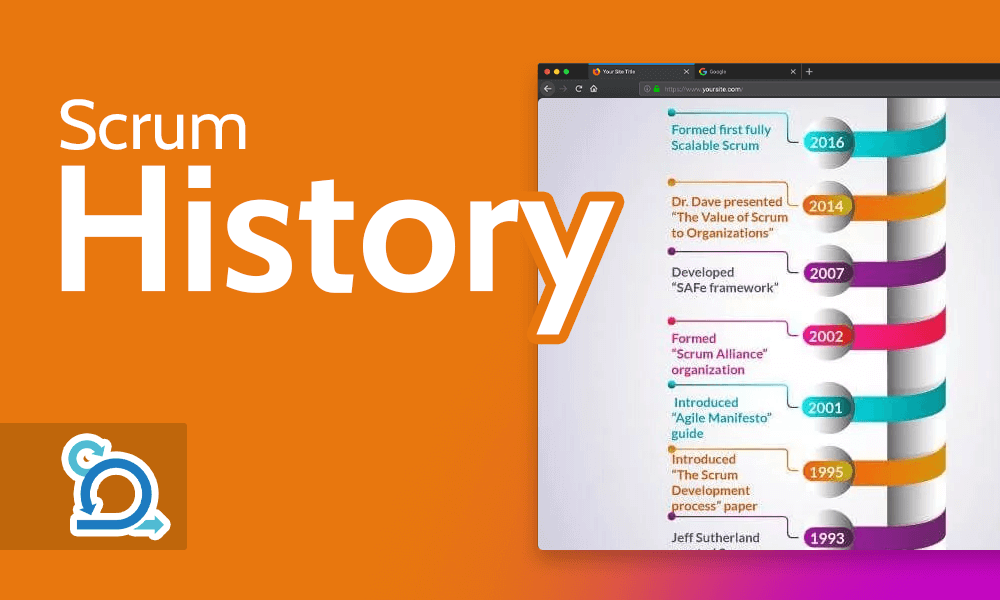
Scrum History: A Timeline
Scrum may only have been around for three decades, but the Agile process has a fair amount of history behind it. From its inception in 1986 to today, where Scrum practitioners are easy to come by, the Agile process continues to break project management ground. Below, we will cover every significant event that has shaped Scrum.

1986: Harvard Business Review & The New New Product Development Game
In 1986, two university professors — Hirotaka Takeuchi of Harvard and Ikujiro Nonaka of Hitotsubashi University — examined the work processes of several American and Japanese manufacturers (Canon, Fuji-Xerox, Honda, Epson, Brother, 3M and Hewlett-Packard).
The pair discovered each company was using a holistic approach to manufacturing that broke away from traditional methodologies.
The holistic approach had six key elements: built-in instability, self-organized teams, overlapping phases of development, multi-learning, subtle control and organizational transfer of learning. These six elements created a fast, flexible method for creating products.
An article written by Hirotaka Takeuchi and Ikujiro Nonaka was the first document to discuss the working approach that would later be known as Scrum.
Takeuchi and Nonaka likened the method to a rugby scrum. In a scrum, a group of players works together to win the ball back for their team, and then each player plays a vital role as the team moves the ball down the pitch to score a “try.”
At this point, the project management methodology hadn’t been named Scrum, but its ties to the rugby play had been made. The professors wrote a paper entitled “The New New Product Development Game.” Their report covered the processes they had witnessed and got published by the Harvard Business Review.
1993: First Implementation of Scrum Framework
While word of the holistic approach to working was put on the map in 1986, it wouldn’t start to become popular until 1993. That’s when Jeff Sutherland, Jeff McKenna and John Scumniotales of the Easel Corporation first used it in software development.
While we might use digital tools like Jira now to implement Scrum, the methods that drive it haven’t changed since the original implementation that used whiteboards with sticky notes.
The group took the ideas from Nonaka and Takeuchi’s paper and tweaked the processes they already used. As a result, Scrum development started, and the first Scrum team was born.
1995: The Scrum Development Process
After two years of tweaking and formulating Scrum practices, Jeff Sutherland and Ken Schwaber jointly presented The Scrum Development Process during the Object-Oriented Programming, Systems, Languages and Applications (OOPSLA) conference in 1995. This paper would go on to become the standard reference guide for Scrum terminology.
The concept of Scrum and how it can be used to develop
software was shared with the world in 1995.
2001: The Agile Manifesto
After years of fighting with rigid, document-intensive traditional project management approaches like Waterfall, software developers reached a breaking point. Jeff Sutherland and Ken Schwaber joined forces with 15 other programming evangelists to create a group called the Agile Alliance.
The Agile Manifesto laid the foundation for all modern Agile frameworks.
Together, the group produced the Agile Manifesto, a document that laid the foundation for Agile methodologies. The manifesto describes four values — interactions over processes and tools, working software over comprehensive documents, customer collaboration over contract negotiation and responding to change over following a plan — and 12 principles that Agile teams must follow.
2001: Scrum Alliance
In 2001, Ken Schwaber, Esther Derby and Mike Cohn created the Scrum Alliance. The Scrum Alliance’s mission as a consultancy and certification organization was to teach as many people about Scrum as possible. In the years following its founding, the organization created the popular Certified Scrum Master (CSM) certification.
The Scrum Alliance is a nonprofit Scrum consultancy and certification organization.
2006: Scrum Inc.
In 2006, Scrum co-creator Jeff Sutherland created his own company, Scrum Inc. Much like the Scrum Alliance, Scrum Inc. offered Scrum training courses and consultancy services. Sutherland went on to create the scalable Scrum@Scale framework, which helps companies spread Scrum methods over entire organizations.
Scrum Inc. is a for-profit Scrum certification and consultancy firm.
Scrum Inc. continues to offer many courses for those wishing to pursue a career in Scrum. You can choose from Registered Scrum Master (RSM), Registered Product Owner, Registered Agile Coach, Registered Scrum@Scale Practitioner and more.
2009: Scrum.org
In 2009, after a falling out with the Scrum Alliance board of directors over certification paths, Ken Schwaber founded his own company, Scrum.org. Like the Scrum Alliance and Scrum Inc., Scrum.org started offering numerous Scrum training courses and certifications.
Ken Schwaber founded Scrum.org in 2009.
Scrum.org is known for offering the Professional Scrum Master (PSM), Professional Scrum Product Owner (PSPO), Professional Scrum Developer (PSD) and Professional Agile Leadership (PAL) certifications, among others.
2010: Scrum Guide
After previously taking separate paths, Jeff Sutherland and Ken Schwaber joined forces to create the first Scrum Guide. The pair wanted to clarify what Scrum is and how understanding the roles, events, artifacts and rules that define the methodology can help teams become more efficient. We also have a helpful What is Scrum guide that can help you understand these concepts.
The Scrum Guide is free to download as a PDF from scrumguides.org.
Schwaber and Sutherland’s Scrum Guide received global acclaim for its relaxed and easy-to-follow approach to teaching what can be a quite complex methodology. The Scrum Guide is updated fairly regularly, with the last major update being in 2020.
2015: The Nexus Framework & Scalable Scrum
We know that Jeff Sutherland created the Scrum@Scale method, which helps teams scale across organizations. However, in 2015, Ken Schwaber developed another scalable Scrum method, the Nexus Framework.
The Nexus Framework is a Scrum scaling method for companies
that want to use more than one Scrum team per project.
The Nexus Framework is for companies with multiple Scrum teams working on one product or project. As a side note, scaling Scrum (which is the art of getting multiple teams to work together) and the Scrum of Scrums (which is a meeting held between multiple teams) should not be confused.










